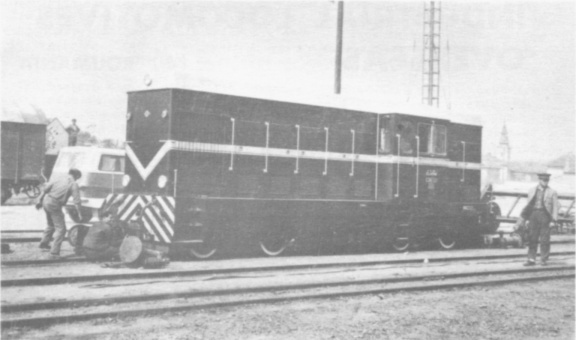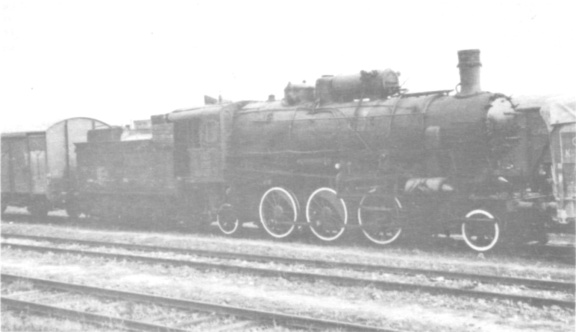
| THE INDUSTRIAL RAILWAY RECORD |
© DECEMBER 1967 |
INDUSTRIAL LOCOMOTIVES OVERSEAS
(6) ROUMANIA
D TREVOR ROWE
During a visit to Roumania in September 1966 I managed to visit all the State Railways (Caile Ferate Romane) narrow gauge lines shown in the public timetables with the sole exception pf a short section near Bucharest, and was pleased to find them one hundred per cent steam operated, with both tank and tender engines of various types. I should mention that all the State narrow gauge lines we traversed were of 76cm gauge, and I would say that all the narrow gauge industrial lines we saw were also of this gauge, some of them physically connecting with the State lines.
The first sight of an industrial locomotive came when travelling from Timisoara to Caransebes. At Gavojdia we passed the terminus of a narrow gauge line, noting two 0−8−0T’s, one numbered 1 and bearing the Roumanian builder Resita’s works plate. This line has passenger stock lettered UCN and continued off towards the distant hills; it would well repay a visit which would be quite practicable as a day’s outing from Timisoara. A little later the same day, at Voislova, between Caransebes and the start of the rack section on the line to Subcetate, we saw another narrow gauge line, again with passenger stock and a small tank engine lettered IMR 3. Riding the State narrow gauge line from Alba Iulia to Zlatna we found at the latter place a factory with a narrow gauge 0−8−0T lettered IMC ZLATNA 1 and built by Resita in 1955. Possibly there were other locomotives at this works. On returning to Alba Iulia we found a brand new narrow gauge BB diesel being prepared for delivery to the works at Zlatna. This was lettered UZ+CH−MET ZLATNA no.L35H012 (something like Uzinele Chemical Metalurgic at a guess?) but bore no worksplate.
Our next industrial was a standard gauge one; on changing trains at Vintul de Jos, near Alba Iulia, we noticed a Hungarian type 2−6−2 marshalled in a freight train and closer examination showed it to be lettered TUG 324.761. This series of numbers is carried by both Roumanian (CFR) and Hungarian (MAV) locomotives and so it may well have been ex−main line. It had probably been to a CFR works for repair and it would be interesting to know where it operates, as 2−6−2 passenger locomotives are an unlikely industrial type! Shortly after leaving Vintul de Jos, in the direction of Sibiu (I believe at the station of Serbes Alta) we noted a standard gauge 2−6−2T lettered IFS 375 (?), possibly another main line type now in industrial use.
Back on the narrow gauge near Praid we noted a long, probably timber carrying, narrow gauge line. At Tirgu Mures, a small industrial narrow gauge diesel, No.3, was noted. Near Oradea Est main line station, oil tank wagons are worked over the city tram tracks by a standard gauge 0−4−0 diesel, the trams having to operate "single line" while this is in progress!

The new diesel for the Zlatna works at Alba Tulia, 14th September 1966.

The mysterious TUG 324.761 at Vintul de Jos. (Both photographs by the Author)
I was pleased to see in FACS Revue No.77 (the magazine of our affiliated society in France) some notes written by a Roumanian contributor and dated August 1966. He mentions that the Forestry Commission (Caile Ferate Forestiere) operates more than 100km of railways of 60cm and 75cm gauges. (As the CFR is 76cm gauge it seems likely that the CFF is 76cm also). The most important 75cm gauge line leaves Orastie, near Deva, and runs 42km to Gradistea Muncelului. The journey takes seven hours and passengers are permitted to travel free as the line is the only was of getting into the mountains. The one daily traibn leaves Orastie about 05.00 and with a stop of 2½ hours at Valea Rea the terminus is reached about 13.00. In the evening the return journey is made by gravity, with two brakesmen per wagon of tree trunks. The other lines of 60cm gauge are mostly in Upper Moldavia at Dornisoara, near Vatra Dornel; at Borca, in the Bistrita valley; and in the Central Carpathians (Timis valley, a system near Armenis, and at Horezu, near Rimnicul Vilcea). On all these 60cm lines motive power is supplied by wood-burning 0−6−0Ts built by Resita in 1958, one on the Borca line being No.7 NOIEMBRIE.
The foregoing information is incomplete, but is meant to serve as a guide for future visitors who will find Roumania a very friendly country, surprisingly free from the usual East European suspicion and lack of sympathy for railway photography.